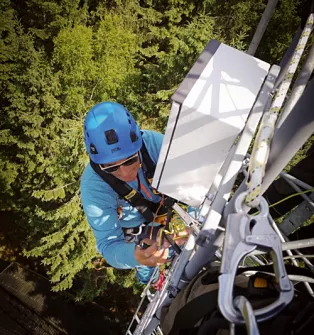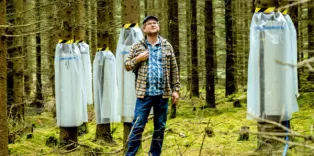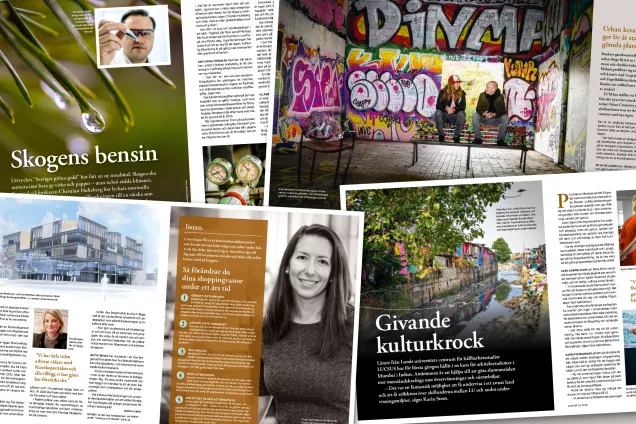The soft moss extends like a pleasant wall-to-wall carpet on the wooded slope next to the Hyltemossa research station south of Perstorp. The air carries the fresh scent of the surrounding conifers, and gentle raindrops herald an approaching shower.
Many of the trees in the area are numbered with bright yellow plastic tape. On some trees, wires snake around the bark. Other tree trunks have been covered in protective plastic so that, with a little imagination, and in the right twilight, they could be mistaken for ghostly beings. A visitor can hardly avoid noticing that some sort of research work is going on here.
“All our data is open. Other researchers are welcome to use our data for their own projects, for example to study carbon sequestration in Swedish woods or how the climate affects forest growth”, says Janne Rinne, who is a professor of physical geography with overall scientific responsibility for the research station.
During our walk in the forested area, he talks about all the various data that the researchers are collecting. This includes meteorological data such as temperature, air humidity, wind speed and solar radiation. The temperature is registered from one metre down in the ground to 150 metres up in the air. The researchers also measure the greenhouse gases carbon dioxide, methane and nitrous oxide – data that constitutes the core of the extensive European research collaboration ICOS, which consists of a network of measurement stations all over the continent.
“And here, we measure the trees’ temperature. It is measured under the bark”, says Janne Rinne, pointing to the cables taped to one of the tree trunks as we pass.
In addition, the researchers at Hyltemossa are now studying aerosols, airborne particles, since the nuclear physicists moved their field measurements to Hyltemossa two years ago. In a couple of completely new projects, the nuclear physicists are collaborating with the physical geographers on the study of particle emissions from spruce trees.
“The trees naturally emit a kind of reactive gases that then form particles in the air”, explains Janne Rinne.
These airborne particles probably have a cooling effect on the climate by contributing to increased cloud formation in the atmosphere, but our understanding of this type of mechanism is still limited due to the shortage of studies conducted on coniferous trees. Thanks to the investment in the project on airborne particles in Hyltemossa, the research station is now included in a further EU network connected to climate research: ACTRIS. Nuclear physicist Adam Kristensson at the Faculty of Engineering is responsible for the measurements taken at Hyltemossa within ACTRIS.
Janne Rinne emphasises that the Hyltemossa research station is also accessible to other research fields that might benefit from the facilities. The research station has several rooms for overnight stays as well as a kitchen, a workshop and a little lab space, office and internet access.
After a short walk in the woods, we reach the foot of the 150-metre mast. It was erected in 2014, two years before the lower mast. Research engineer Michal Heliasz, who has also accompanied us in the woods, explains that it takes around 30-40 minutes to climb to the top of the highest mast. Now this needs to be done every other week, as a couple of sensors in the measuring equipment need to be cleaned.
“Although in the winter, when it is cold and windy, it takes ten minutes longer to climb up”, says Michal Heliasz with a fairly neutral expression.
Michal Heliasz is responsible for the research station’s ongoing service work, both on the ground and up in the air. Working on the masts requires training, certification and safety equipment. There must always be two people together at the top, for safety reasons. If one person should become ill or injured up on the mast, it is no use calling the emergency services; instead, the climbers must rely on one another and on the long descending rope that must always be brought up.
LUM’s reporter looks towards the top of the mast and wonders whether those authorised to climb it have ever amused themselves by seeing who could get to the top fastest. Michal Heliasz smiles, but shakes his head.
“Nope, but it does happen that we stop and take a picture of the view sometimes, when we have a bit of extra time”, he says.
Text: Lena Björk Blixt
Photo: Kennet Ruona
Facts:
The research station at Hyltemossa has been operational since 2014. It is located in a coniferous forest of 30-year-old trees. The forest is privately owned and commercially managed.
Recently, intensive work has been carried out to set up equipment for new projects on airborne particles. The initiative means that Hyltemossa will soon become one of the world’s few so-called atmospheric flagship stations, i.e. measurement stations that make cutting-edge measurements and data available to increase our understanding of how the soil, forest, particles and gases interact in a changing climate.




